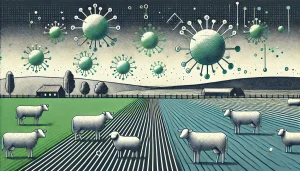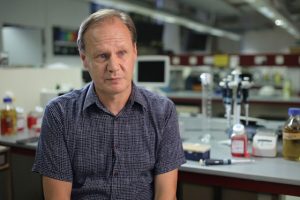Double Lifespan
Geneticist David Sinclair on a long-liver nematode worm, living organisms' recovery systems and a special diet...
Let’s consider how radiation arrives from the Sun. It comes through the atmosphere and arrives at the surface, and then what happens to it? It’s either absorbed by the surface and the surface heats up, we evaporate water, we’re keeping warm, or it’s reflected. But what happens in the intermediate bit where there are plants? We know that plants cover large fractions of the terrestrial land surface, and we depend almost entirely on plants. I’d go as far as to say ‘entirely’ because even when we look at resources from the ocean, the food material that we take out of the ocean, the bottom of the food chain is also dependent on plants, phytoplankton in the ocean.
So why and how is this arisen, this whole system that is so fundamentally based on capturing sunlight, what is it? Of course, that is photosynthesis. Photosynthesis is the process through which pigments in plants (and animals to a certain extent, but plants), primarily chlorophyll, absorb radiation from sunlight, so these pigments have evolved to absorb that radiation and turn it into something useful. The process of photosynthesis, if you think about where it goes and what happens to it, enables plants to capture energy and turn it into a useful thing. What do I mean by useful? It enables them to take sunlight, carbon dioxide and water: it’s a very simple equation in one sense, you have carbon dioxide and water, the things that you need from the outside, material. What chlorophyll does is a very complex chemical process that allows you to use sunlight to break those carbon dioxide and water down and turn them into much more complex molecules, particularly sugars. The sugars are the things that you can use to drive biological energy processes that you can pass on to the tissue within plants and that allows them to function, it allows them to move stuff around and particularly to build tissue.
Those sugars are the food that allows plants to grow bigger and produce mass. Obviously some of that mass is tissue that in different types of plants goes to different places, so woody plants produce woody material that has a lot of cellulose and lignin, and it produces an architecture that allows you to grow bigger and taller. If you are a grassy or flowering plant you have much smaller structure that’s mostly cellulose. Those structures when grown contain that energy in some sense, they contain that energy in the tissues that are grown by the plants. It’s lucky for us because then what happens is that there is a whole system of other life on Earth, particularly above the surface of the ocean that is dependent on that and can use it in some way. The plants very kindly have captured the sunlight and turned it into sugars and other more complex carbohydrates and it’s a lot easier for other organisms to come along and exploit the energy in those complex carbohydrates. So if you’re an insect, or a mammal, or a fish it the ocean you can come along and exploit that energy that has been captured by the plants. So the plants do all the hard work and then the animals come along and eat it and that provides the basis of the food chains the ocean and the food chains on land.
So photosynthesis underpins all of that. You’d think: well, photosynthesis must be a very well understood process. That’s the really interesting thing. Photosynthesis is such a fundamental part of life on Earth, but just as an aside: up until about 30 years ago it was thought that essentially photosynthesis drove all life on Earth. So I’d say “nearly all life on Earth”, that’s not quite true, in that about 30 years ago we discovered organisms on the bottom of the ocean living around what’s called black smokers which are geothermal vents which are spewing hot, very nutrient-rich water from deep in the geological strata into the bottom of the ocean. These small islands of life were discovered that exist in very deep parts of the ocean that are somehow able to exploit things like silicon phosphorus. That’s an amazing thing in itself in that up until 30 years ago photosynthesis was the only route to life on Earth. Now there’s been another window opened and that is very interesting because up until then, if you were looking for life on other planets, your hypothesis would be that some form of the photosynthesis-like mechanism has to have occurred. Finding these organisms existing on the bottom of the ocean completely independent from sunlight meant that completely separates ecosystems can evolve entirely in the absence of sunlight. That means that we’re all better off as far as looking at life on the planet is concerned because it’s evolved at least twice on Earth using completely different mechanisms. So if it’s happened twice who’s to say that hasn’t happened twenty times, we just don’t know where to look.
Going back to photosynthesis, of course, there’s been a lot of effort to try and understand photosynthesis from the perspective of pure science. How does it work? Because if you know how it works then you can potentially model it and you can potentially exploit it though it’s actually a very-very complex process. When scientists started looking at the photosynthesis process in the early part of the 20th century right through till now some major breakthroughs have occurred in our understanding of different parts of this process, but our full understanding is still a long way from complete. That makes it very interesting scientific question but one that also then presents us with a difficulty because thinking back to climate and the carbon cycle, the biogeochemical parts of the carbon cycle in terms of plants, one of the key things that we need to think about is how we incorporate photosynthesis. Because the photosynthesis is the driver: the sunlight comes in and the photosynthetic operators of the plant are what turns that sunlight plus the carbon dioxide plus the water into useful material and then releases oxygen back into the atmosphere.
That whole cycle needs to somehow be included in our models. This is where it gets complicated, as it always does, because the answer is never simple. This process happens at the individual leaf scale, happens within the individual cells scale within the leaves. Great. But unfortunately, we want to look at the whole of the organism, or the entire tropics, and understand what the carbon budget is from photosynthesis.
That aim and then understanding how this photosynthesis scales up to very large scales is a very challenging problem. Lots of interesting things have been found over the last few years. Again, the combination of new observations from satellites and from other kind of observation networks that’s one of the things that were helpful, so the ecological community have really opened up this field by combining observations of lots of different scales. One of the things that happened over the last 20-30 years is these CO2 flux measurements and networks of these things. That is a tower maybe just a bit taller than the canopy (some of them are taller than that but a lot of it are just a bit taller than the forest canopy), so maybe 40-50 meters in the tropics and 30 meters in deciduous woodland. On the top of that tower you have an infrared gas analyzer that measures how much CO2 is passing in and out of a given little parcel of an atmosphere at any one time. It also measures the vertical and horizontal wind speeds, so it tells you how the wind is moving and how much carbon dioxide there is in this little piece of atmosphere that’s going parts.
The reason why that’s useful and really interesting and has really opened our eyes is because you’re monitoring how carbon dioxide is passing and coming into and out of this canopy and you monitor over day and night, what you’re seeing is the piece of vegetation, whether it’s crop, or forest, or whatever you’re seeing it breathing. You’re seeing the results of photosynthesis is going on, so we look at these measurements: they are taken continuously over months and years every 30 seconds. You capture the real dynamics of photosynthesis and the way the plants are carrying this out. So what you do is you see the carbon dioxide levels are going down during the day as a plant starts photosynthesizing, the Sun comes up, photosynthesis starts, the plant starts to really draw down the carbon dioxide. They’re maximally photosynthesizing during the middle of the day, assuming there are no constraints to sunlight (rainfalls and so on) and then by the evening it drops off again. In the nighttime the photosynthesis stops. So you see this daily pulse of up and down carbon dioxide and if you have these towers not just in one place but across whole forests and across whole continents you see this process of photosynthesis going on at scales of a few meters right up to very large scale.
So our understanding of photosynthesis needs to be done at these very different scales under these new observations that we are making combining satellites, combining models and these kind of gas flux measurements which are giving it a perspective on the dynamics of photosynthesis, how it changes and how it will vary with temperature and rainfall all across the globe.

Geneticist David Sinclair on a long-liver nematode worm, living organisms' recovery systems and a special diet...

How the human immunodeficiency virus (HIV) emerged, how to protect against zoonotic diseases, and why vaccinat...

Molecular Biologist Greg Towers on HIV discovery in San Francisco, antiviral drug therapy and current areas of...